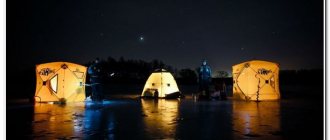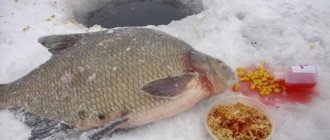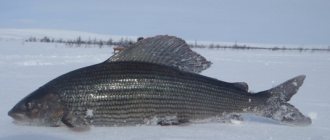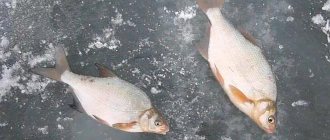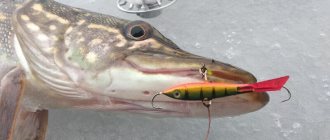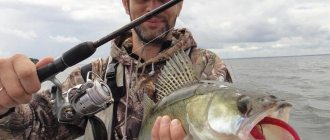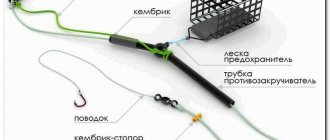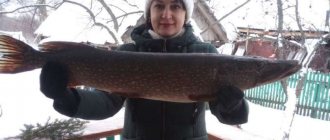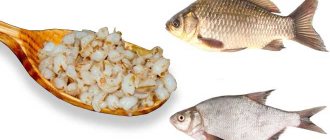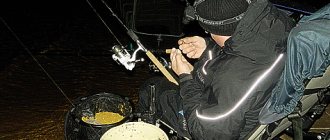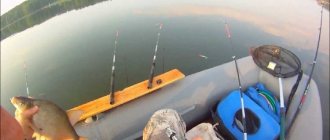Experienced winter bream fishermen choose to catch bream in winter at night. And this is not just like that. The largest flocks go out to feed at night, visiting relatively shallow tables, slopes and edges adjacent to the sites. At night you can count on catching especially large specimens. On many water bodies in winter, large bream are simply not caught during the day, and daytime anglers are content with small bream in their catch.
Necessary equipment: heat and light
To catch bream on a winter night, you need to prepare warm clothes, gloves, and special shoes with felt soles. The size of felt boots is selected in such a way that the toes can move. To achieve the necessary comfort and warmth, first put a wool sock on your foot, then a cotton sock. Take with you an individual first aid kit, which should contain iodine and a bandage in case your fingers are pierced by spines or fish fins. It is recommended to set up the tent in the evening, at sunset. Its height should preferably correspond to the height of a person, and the floor area to the number of people in it. It is advisable to go fishing for bream with at least two people, it is much more fun. Tents without a bottom are often used, although some products have special holes in the polyurethane foam floor for drilling holes. In such a room, minimal comfort is required; fishermen take with them chairs for sitting and a fishing box. Winter nights are quite cold, so a camp stove for boiling water is a good idea. In their free time, fishermen can make themselves coffee or tea to warm up. Note! If you need to get maximum comfort while fishing, then take with you a gas stove with a power of about 2 kW. Such a unit will be enough to heat a small tent. You need to think about lighting in the tent in order to observe the fish bites. A kerosene lamp is not suitable for this purpose, because the heat generated by it begins to melt the ice. Here it is better to use headlamps equipped with LED bulbs. Such a light source is capable of illuminating the hole and the winter fishing rod installed above it. Batteries quickly lose their charge in the cold, so additional batteries are tucked into your bosom. Some models of flashlights with powerful streams of light can be connected to a car battery, which will make it possible to illuminate the entire tent.
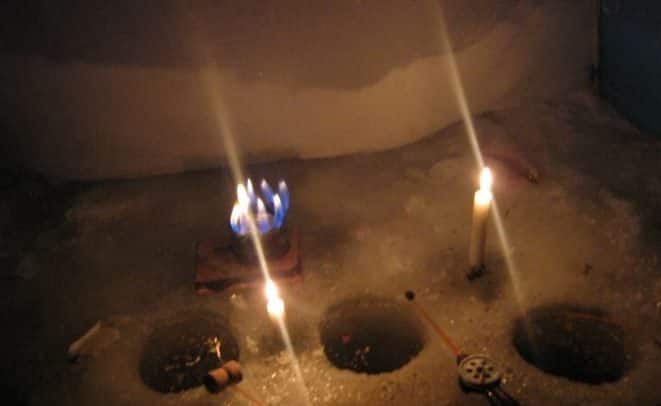
Night fishing equipment
Choosing a tent
It is very important to choose the right tent. You should not skimp on a tent, because the degree of comfortable stay on ice depends on its design and size.
We have 3 main types of tents:
- Tents made in China with composite poles. They look very elegant, it would seem - this is the ideal option for a novice fisherman. But alas, this is not so. If you ask the seller to take out and disassemble the tent, he will come up with a hundred reasons not to do this. But if you did, then after the demonstration the tent flatly refuses to fit into its own cover. Much more serious problems begin directly on the reservoir. Firstly, to perform such a miracle on any sensitive breeze alone is a truly impossible task (this is the main drawback). Secondly, it’s better to keep silent about the pegs that come with this tent. I don’t know in whose fevered mind the idea was born that this could even be fixed on ice? Accordingly, you will have to make the pegs yourself or drill holes and insert spacers into them. I strongly recommend not to believe the label on the packaging, which states that the tent is a two-person tent. Better look at the internal dimensions given and think about how you and your friend will fit comfortably in a space of 175 by 175 cm.
- The tents are self-folding. In its case, such a tent looks like a big pancake and is carried on a belt behind your back. The advantages are that it is inexpensive, compact, and really easy to unfold. But putting it back into the case is a slightly more difficult task.
- Umbrella tent. Easy to unfold, easy to assemble. Disadvantages include the relatively high price and large dimensions. But the comfort is worth it.
It is advisable to place the tent at one of the corners towards the wind, and position the entrance so that the wind does not blow into it. Before finally securing the tent, it is necessary to mark and drill holes, because... It is better to sit above them in the middle of the tent, where the ceiling is higher, and not at the edge, where you will fish in an uncomfortable, constantly bent position.
Night fisherman's equipment
A trough sled on a rope is best suited for transporting fishermen's belongings and, most importantly, the catch.
The lighting issue is easily resolved. There can be no alternative to a headlamp. However, be sure to bring a few regular household candles with you. Firstly, candles lit in a tent significantly raise the internal temperature, and secondly, when fishing for really large specimens, the “headlamp” has to be turned off, otherwise the fish, frightened by the light, really doesn’t want to go into the hole. To prevent the fishing line from burning when fishing, candles should be placed in the corners of the tent. If you are ready to purchase a gas lamp, then this will be the best option.
Don't forget to take a trash bag with you! It’s sickening to see what a dump some anglers can turn the area around the hole into.
The requirements for clothing are very lenient. It’s always warm in the tent and there’s no wind; you usually sit without a jacket. Thermal underwear, a medium-thick fleece sweater and pants are an ideal choice. On top of the fleece pants, you should wear some simpler pants so that you don’t mind getting them dirty.
But it’s better to take a closer look at your shoes - the soles still touch the ice. If there is slush and ice on the street, wet and slippery, you just need to have shoes with studded soles, or “crampons” (ice shoes) worn over regular shoes.
Gear selection
To catch bream from ice at night, you need a standard winter fishing rod. In practice, several types of rigs are used for catching bream: • classic design - nod, fishing line and jig; • bite alarm, fishing line and hook; • equipment consisting of a set of hooks, “garlands”; • tackle, which includes a float, fishing line and hook. In some cases, a winter fishing rod is equipped with a small bell; it gives a sound signal when a fish bites. Optimal results can be achieved by using a “devil” jig. Large specimens are caught on this bait. Important! Catching bream with a garland rig gives better results than fishing with a jig. The described tackle consists of a final sinker and a central fishing line, to which several leashes with hooks are attached, their length should not exceed five centimeters. Using a garland for night fishing for bream involves the use of baits, so the game is inappropriate here. At night, a jig has lower reliability indicators than a regular hook, and such a product works much worse. A jig fishing rod receives the movement of the guard not from bites, but from the blows of the fish on the fishing line. Using equipment with a regular hook is much more successful; bream is caught with almost every bite. In addition, the fisherman can take a short nap by securing his fishing rods near the hole.
Winter bream rigs
Bream are caught in winter using float and nodding tackle.
Float tackle for bream in winter
The fishing rod for catching bream in winter is as follows:
- short rod;
- reels with wound monofilament line;
- main line with a cross section from 0.1 millimeter to 0.16;
- float with a short keel and antenna;
- small jig or hook.

Several fishing rods are equipped at a time to adapt them to fishing conditions. A luminous antenna is attached to the float so that it is visible in the dark. The float tackle should be overloaded so that only the antenna is visible above the water.
Fishing with nod tackle
Bream fishing is active in winter with nodding tackle. It is based on a nod, signaling a bite by bending or straightening. It is made from coarse material when caught in the current, sensitive - in calm water.
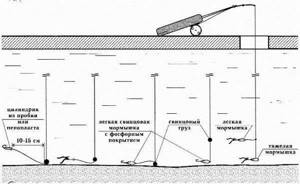
Read also: Helicopter fishing in winter
The equipment of a nodding fishing rod is similar to a float fishing rod, but there is no float or hook. Instead of the latter, a jig is used. For passive fishing, a devil suspended at an angle is suitable.
Lower the bait just above the bottom of the reservoir, starting to smoothly twitch the rod up and down. As soon as the nod begins to change position, they hook the fish. In deep places the hook will be wide. Since the bream bites carefully, the nodding movements are barely noticeable. An important component of successful fishing is the stretchability of the monofilament line. After the first ten seconds of violence, the fish will begin to rise up and here you need to have time to select a fishing line, bringing the fish’s head into the hole.
Read also: Fishing with a garland, Fishing with the devil in winter
What should be the bait for bream?
To get a good catch, you need to feed the bream on the pond; when it smells the food, it will approach the hole. When searching for fish, you need to use a bloodworm-poor mixture. This component of animal origin is added only for odor in an amount of 2-3 grams per feeder. The composition of the main bait for night winter fishing for bream is as follows: 1. Classic bait for catching “peaceful” fish, about 0.5 kilograms. 2. A glass of crushed, roasted sunflower seeds. 3. Steamed millet, about 0.2 kilograms. At night, when small fish are not particularly active, the amount of bloodworms in the bait should be increased to the maximum. This component will attract and keep active bream in the fishing area. If possible, then the amount of bloodworms is taken equal to the rest of the bait mixture (proportion 1 to 1). Animal feed is buried at the bottom under a layer of plant components, which will allow the fines to be removed. Bream easily picks out red worms from under a layer of crackers and other plant foods, but this is problematic for small fish. In order for the bloodworm to end up at the bottom of the reservoir, it is placed on top of other food in a tilting feeder. Note! At night, additional feeding of fish is not carried out; operations with lowering the feeder can scare away accumulated schools of bream. It is advisable to do feeding in the evening, installing three or four feeders in each hole.
Conditions for catching bream in winter at night
several holes are drilled in each promising place , bait is made, after which (after 20 minutes) fishing is tried . If there is no bite, then try another place. Periodically, different points can be additionally fed and checked again.
But even if the first tests were successful, you should not think that the best place for fishing has been found. The flock may move, and other feeding holes will have to be checked.
Bait can be done either using a feeder or simply by throwing the mixture into the water . You can set up a tent at the same time as bait. While the tent is being set up and the place is being arranged, the bait will do its job.
The “classic” is usually used as bait – bloodworms for catching bream at night in winter . You can fish with a jig.

How to catch
First, a little about the equipment; it must have high levels of strength and reliability, and quickly lower the bait (a bunch of bloodworms) to the bottom of the reservoir. Select a weighty jig, the cross-section of the fishing line is 0.12 millimeters. Some fishermen practice fishing with a winter fishing rod and a float. Bite alarms at night are especially important. Many fishermen successfully use a special signaling device - the so-called “Crossbow”. They put a rubber ring between the horns of the rod, insert a plastic stick between the rubber band and make several turns, usually no more than eight. During casting, the line is tensioned, and it holds the stick in a given position. If you loosen the thread, the elastic band will unwind and the alarm will make a loud knock on the flyer. The bream takes the bait from the bottom and immediately rises to the upper layers of the water, this will contribute to the unwinding of the fishing line and the activation of the alarm. A fisherman, even one who is dozing, will be able to figure out which rod the fish bit on and will quickly make the hook. Important! Absolute silence must be maintained in the tent; loud sounds and stomping are unacceptable. You need to talk in a whisper, otherwise you will have to look for a new place to hunt bream. Some “winter campers” practice fishing not only in a tent, but also in outdoor holes. This is especially true in warm weather. If there is no bite in the main place, go to the outer holes. In each of them, they make up to 5 lifts with a jig; there is no point in sitting further. There are times when the bite in the outdoor holes is much better than in a tent, so you have to spend the whole night in the cold.

In the case when the external holes are as promising as the external ones, it is also advisable to feed them. If the bite in the tent weakens or the fish breaks off, you need to immediately fish the holes in the neighborhood before the bream leaves the feeding areas. The presence of this fish can be determined by the twitching of the floats or nods from the fishing line touching the scales or fins. In this case, there is no need to rush; a bite is indicated by a float falling on the belly or a nod raised upward. It is at this moment that you need to hook. During fishing, the fish caught on the hook rests for a long time, winds in circles and can catch the gear located nearby. In this regard, the holes should be located at the maximum possible distance from each other. It is not recommended to pick up a bream that has swum to the surface with your hands; a pointed hook is used for this purpose. After a deft movement of this tool, the fish appears on the surface.
